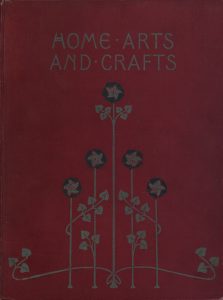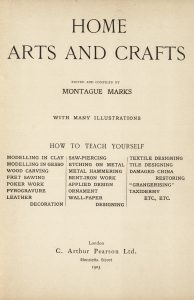Contemporary Context
1903 – “Extra Illustrating,” or “Grangerising”
Context
Long after The Woman in White first appeared in print, grangerization and extra-illustration continued to be a celebrated practice. This instructional overview of extra-illustration and grangerization appeared in a 1903 London publication titled Home Arts and Crafts. The text gives a glimpse into some of the strategies that creators used to prepare printed media for repurposing, something that allowed extra-illustrators and scrapbookers to take matter that “otherwise would probably be thrown away” and make it their own.
 |
 |
“EXTRA ILLUSTRATING,” OR “GRANGERISING.”
“Extra illustrating,” as the term is used by collectors, means gathering portraits of the persons and views of the places mentioned in any given book, and having the book handsomely rebound, with each portrait and view placed opposite the page where it is mentioned. Drawings, water-colours, prints or photographs, autographs—indeed, all things of the kind that pertain to any person or incident mentioned in the book—have a claim to a place in it. The pastime is fascinating and pleasurable, for pleasure consists not so much in the acquisition of a desired object as in the pursuit of it, and book illustrating is a constant pursuit of coveted prints. It is, moreover, instructive, because the collector makes himself acquainted with the history of the persons mentioned in the book he is illustrating, which leads him to read other books, and in time he becomes thoroughly conversant with the history of the period of which his book treats. The hobby is closely allied to “ bibliomania,” and is generally indulged in by persons who have fine libraries.
As there are books and books, so are there illustrators and illustrators. One man will be satisfied with the work of a professional illustrator, to whom he will send a volume to be thus interleaved; another will gather his illustrations from many sources and select such as his own taste decrees fit; another will embellish the work with numerous fancy head and tail pieces appropriate to the subject; and yet another—and happiest is he—who, with ready pen, pencil, and brush, can add a copy of some portrait yet unengraved or the sketch of a locality still unlimned. How it makes a brother-collector’s mouth water and his fingers itch to see such within the leaves of another’s book, which he, too, is illustrating!
One illustrator will be satisfied to have his print, autograph, or letter in any state, merely because he has it on the list, and once obtained that particular item can be stricken off; another may buy in succession a dozen impressions of one desired print, and yet keep on the look-out until the volume is finally bound for a still better impression of it.
In London in 1769 appeared the first edition, 2 vols., 4to, of a book which was the immediate forerunner of all books illustrated by interleaving. Its title, sufficiently comprehensive, was
“Biographical History of England from Egbert the Great to the Revolution; consisting of characters disposed in different Classes and adapted to a Methodical Catalogue of Engraved British Heads. Intended as an essay toward reducing our Biographies to a System, and a help to the knowledge of Portraits; with a variety of Anecdotes and Memoirs of a great number of persons, not to be found in any other ‘Biographical Work.”’
The preface also speaks of the utility of a collection of English portraits to supply the defects and answer the various purposes of medals.
The author was the Reverend Dr. James Granger, and from him this particular method of illustrating takes its name. Living from 1723 to 1776, he was educated at Oxford, but left without taking his degree, and upon entering into holy orders was presented to the vicarage and living of Shiplake, Oxfordshire. In the dedication of his book to Horace Walpole he states that his “ name and person were known to few at the time of publication, as he had the good fortune to retire early to independence, obscurity, and content. . . . .
If he had an ambition for anything it was to be an honest man and a good parish priest.”
Immediately on the publication of his book the leaven[1] began to work. “Five shillings,” says Fitzgerald, “ had been considered by collectors a good price for any English portrait, but at once books with portraits rose in price to five times their original value, and few could be found unmutilated.
Both pompous Dibdin and genial Burton, who were book-lovers of the same degree, but who differed in kind, were bitter enemies of Grangerising, and ridiculed the practice, giving ludicrous examples of book illustrating run mad, the one showing how the first two or three verses of the Bible might be illustrated, the latter taking the first verse alone of “ How doth the little busy bee.” Burton looked upon it as sheer murder—the tearing out the vitals of a friend; and we can imagine the name he would have given the Grangerites had he been living to-day.
But we trust that no one who becomes a book “ illustrator ” through reading this article will mutilate a really rare or valuable book.
In selecting a book to interleave, you may either fear being too ambitious, and obtain “just a little one to begin with ”; or you may start on some historical work, city, county, or national, and continue making volumes out of it indefinitely.
How to split Paper. —Every book “illustrator” should know that seemingly impossible thing —how to split a piece of paper.
It is a very simple matter, and it is said that when it was first discovered in England it was applied so successfully for duplicating bank-notes that the bank authorities were driven to adopt a special paper that would baffle all attempts of the sort. For the innocent purpose of removing the printed matter that so often backs a fine impression of a woodcut or a “process” block the device is invaluable, and the process is not a complicated one. Given practice, patience, and pluck, a satisfactory result is certain.
Having selected the print you wish to detach—which in the first trial should be a worthless one and of small size—trim the margin to a half-inch all round the impression. This is supposing the whole print is about the size of a cabinet photograph. Then have ready some common wheat-flour paste, newly made—which is a very important point, as paste even a day old is apt to spoil the whole operation. Take then two stout pieces of firm linen, muslin, or similar material, a little larger than the print. This should be unwashed stuff—the sort used for rolling window blinds answers admirably. Whatever is chosen must be smooth, firm, and strong. Paste a piece of the stuff on each side of the print. Leave them to dry under pressure, and when nearly set, but not rigid and completely dry, pull the two surfaces asunder with a firm and very even force. Herein lies the whole art of the process, and here also comes failure at first, as the print will either refuse to start splitting, and you but peel off one surface of texture, or else it begins well and tears instead of separating into layers before the whole surface is split.
When you find that the sheet so treated has behaved satisfactorily, and that each piece of linen has a film of paper intact adhering to it, take the one you wish to preserve and soak it in water. Then lift the tender film very gently and mount it with starch upon a suitable piece of cardboard. When mounted, wash all the paste off the right side of the print with a camel’s-hair brush dipped in water. Do this very thoroughly, and then leave the whole to dry under pressure, and the result will astonish all who see it. The film thus gained looks like what the printsellers call an “ India proof”— i.e. a proof printed on India paper. It is so transparent that if, without margin, it is mounted on polished white wood it looks like a transfer picture. Experts at the trick can treat a print of any size in this way with perfect success, and transfer from an illustrated journal, that otherwise would probably be thrown away, a fine impression well worth framing.
Works Cited
Marks, Montague. “‘EXTRA ILLUSTRATING,’ OR ‘GRANGERISING.'” Home Arts and Crafts, London, 1903, pp. 141-143. Internet Archive, https://archive.org/details/gri_33125001403092/page/n151. Accessed 10 May 2019. [Public Domain.]
- "Leaven" refers to the yeast that makes dough rise just as the price for illustrated media rose after Granger popularized this form of collage. ↵

